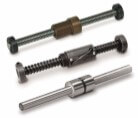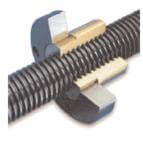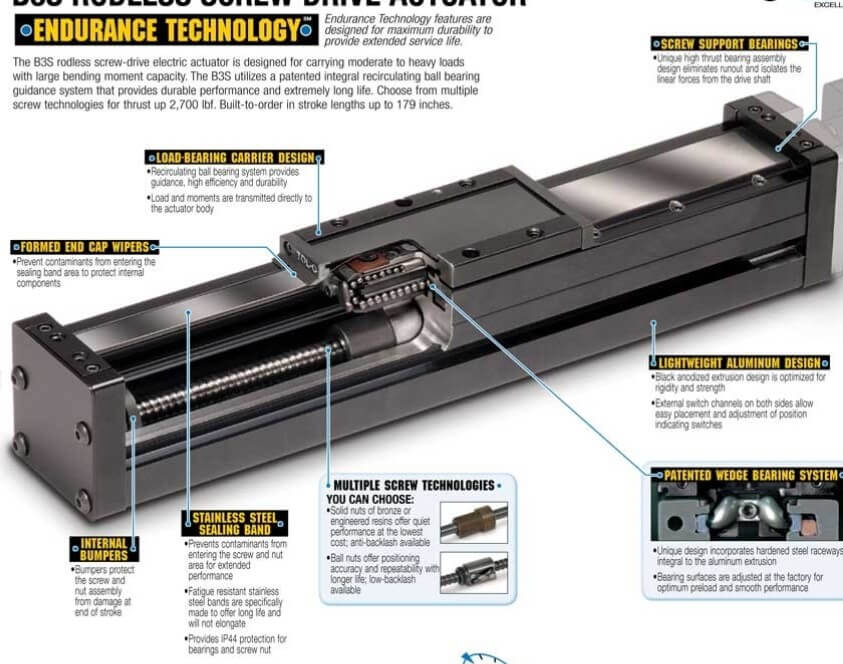Electric linear actuator lead screws – article round-up
By Gary Rosengren on February 9, 2016
 When it comes to specifying an electric linear actuator, selecting the right lead screw* (sometimes referred to as the leadscrew) for the application is critical. That’s because the screw is the major drive component in most electric actuators. After all, if it’s not a belt-driven actuator, then there’s a lead screw involved.
When it comes to specifying an electric linear actuator, selecting the right lead screw* (sometimes referred to as the leadscrew) for the application is critical. That’s because the screw is the major drive component in most electric actuators. After all, if it’s not a belt-driven actuator, then there’s a lead screw involved.
Lead screw types
The choice of screw type can seem simple. There are mainly three alternatives:
- Acme screws ** Very strong. Available in a wide variety of leads and diameters. A good choice in applications that require slow speeds and lower duty cycles.
- Ball screws Get their name from the re-circulating ball bearings that fit between the screw threads and
 corresponding threads in the nut. Available in many diameters, leads, and accuracies. Ideal for applications that require high duty cycles, high thrust, and high speeds.
corresponding threads in the nut. Available in many diameters, leads, and accuracies. Ideal for applications that require high duty cycles, high thrust, and high speeds. - Roller screws Triangular-shaped threads on the screw match multiple threaded rollers in the nut to create a highly effective system for transmitting force. Roller screws are long lasting, low-maintenance, and capable of high speeds and quick acceleration.
To specify the best screw type for a given application, the engineer has to weigh a variety of factors, including orientation, load, speed, and accuracy.
Our guide, Which screw? Picking the right technology, will give you an excellent overview of the advantages and disadvantages of each screw type.
Recent lead screw articles
Helping you understand linear motion is our priority, so we monitor what’s been written on the subject by major engineering publications. Here is a summary of articles on screw drives you may find helpful.
- First, is a blog article from October 2015 Design World, entitled Common ball screw terms explained. In it, you’ll find explanations of common terms like lead, pitch, circuits, and turns. Ball screws are a popular choice in linear actuators due to their accuracy, predictable service life, and reasonable cost.
- Next, there’s Can lead screws outperform ball screws?, another blog article from Design World. The article explains the types of applications in which an acme screw** (see Notes on Terminology) might outperform a ball screw.
- Then we come to Protecting ball screws pays off, an article from Machine Design. Although the article covers the use of these screws in machine tools in general, it points out the potentially detrimental effects of dust and other contaminants on the performance of a screw. Sealing and shielding may be needed in these applications to maximize screw life.
- Finally, there’s A critical look at acme, ball, and roller screws for linear motion and Choosing the best lead screw for a linear motion application from Machine Design, authored by Tolomatic’s own senior mechanical engineer, Igor Gilkin. This pair of articles provides a good introduction to the topic of screw (leadscrew) selection for electric linear actuators.
Learn more
Download our guide, Which screw? Picking the right technology, for an overview of the advantages and disadvantages of each screw type.
Notes on Terminology
*The terms "lead screw" and "leadscrew" sometimes are used interchangeably in the literature. Tolomatic uses "lead screw".
**Some articles treat the term “acme screw” as synonymous with the term “lead screw’ (or “leadscrew”), with ball screws and roller screws put in another class. Tolomatic considers acme screws a type of lead screw along with ball screws and roller screws.
